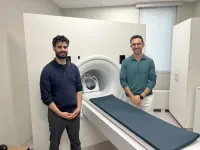(Press-News.org)
If the Chicago region replaced 30% of all on-road combustion-engine vehicles — including motorcycles, passenger cars and trucks, buses, refuse trucks and short- and long-haul trucks — with electric versions, it would annually save more than 1,000 lives and over $10 billion, according to a new Northwestern University study.
The new study, which simulates air quality at a neighborhood scale, also found that areas with predominantly Black, Hispanic and Latinx residents would benefit most.
The study underscores the potential of electric vehicles (EVs) to improve air quality and mitigate human-caused climate change, while also reducing unjust exposure and health burdens — despite EVs sourcing electricity from a grid that continues to include fossil fuel-fired power generation.
The paper was published today (Sept. 13) in the journal Environmental Research: Infrastructure and Sustainability.
“A common misconception regarding EVs is that areas near powerplants — which are often minority communities — disproportionately suffer the burden of poor air quality due to increased electricity demand and powerplant emissions output,” said Northwestern’s Maxime Visa, the study’s lead author. “Our study found that on-road emission decreases more than offset powerplant emission increases.
“The greatest air quality benefits from wholesale EV adoption are co-located with disinvested communities that, historically, have been susceptible to poor air quality due to systemic injustices and their proximity to highly frequented roads and interstates. Our results indicate that vehicle electrification is one potential solution for addressing long-standing air quality-related inequities in and around the city of Chicago.”
The study’s senior author is Daniel Horton, an assistant professor of Earth and planetary sciences at Northwestern’s Weinberg College of Arts and Sciences, where he directs the Climate Change Research Group. At the time of the research, Visa was an undergraduate researcher in Horton’s group; now he is a medical student at Northwestern University Feinberg School of Medicine.
Heavy-duty v. light-duty passenger vehicles
The new findings come on the heels of another study from Horton’s lab, which explored scenarios that replaced 30% of the predominantly diesel-powered heavy-duty vehicles (including short- and long-haul trucks, refuse trucks, and intercity, transit and school buses) in the Chicago area with electric versions. That study found that electrifying 30% of heavy-duty vehicles would save more than 500 lives and about $5 billion per year. In Visa’s study, however, the researchers electrified both light- and heavy-duty vehicles.
“This pair of studies is useful in helping determine which mode of vehicle provides the greatest air quality benefits when electrified,” Horton said. “We found that on a per-vehicle basis, heavy-duty vehicles emit disproportionate amounts of pollutants and greenhouse gases, but given the sheer number of light-duty vehicles on the roads, incentivizing an electric transition across all modes is needed.”
Both studies used a high-resolution air-quality model previously developed in Horton’s lab, which simulates and quantifies pollution levels by neighborhood — tracking pollutants across areas as small as one kilometer.
Impact by the numbers
Based on 2016 energy-generation infrastructure, Visa, Horton and their team found that electrifying 30% of the on-road vehicle fleet across the Chicago region would dramatically slash emissions and pollutants (carbon dioxide, nitrogen oxides, particulate matter, carbon monoxide and volatile organic compounds) with the exception of ground-level ozone.
In the modeled scenario, carbon dioxide emissions decreased by about 15.1 million tonnes (16.65 million U.S. tons) per year. Reducing the amount of nitrogen dioxide and particulate matter in the air would avoid 1,120 and 170 annual premature deaths, respectively. Premature deaths from ozone, however, would increase by about 80 per year.
The researchers also estimate that the greater Chicago region could save $10.7 billion and $1.63 billion in avoided annual health costs related to reductions in nitrogen dioxide and particulate matter, respectively. But the slight increase in ozone would cause an additional cost of $768 million per year.
The number of lives and dollars saved would increase drastically if the power grid shifted to incorporate more emissions-free electricity sources (like wind and solar).
“Almost a quarter of U.S. greenhouse gas emissions come from the on-road sector, making it a great target for climate change mitigation strategies,” Visa said. “However, downstream air-quality effects of vehicle electrification aren’t talked about as often, and our results confirm that they should be. I hope that by showing that EV adoption also leads to cleaner air and important health benefits, consumers and policymakers alike are incentivized to make the switch to cleaner modes of transportation.”
The study, “Neighborhood-scale air quality, public health and equity implications of multi-modal vehicle electrification,” was conducted in collaboration with researchers from the University of Notre Dame, George Washington University, and the Lake Michigan Air Directors Consortium and was supported by the National Science Foundation, the Environmental Defense Fund, the McCormick Center for Engineering Sustainability and Resilience and the Ubben Program for Carbon and Climate Science at the Paula M. Trienens Institute for Sustainability and Energy at Northwestern.
END
Philadelphia, September 13, 2023 – There is already robust evidence that people living with cardiovascular disease are disproportionately affected by poor air quality and extreme temperatures, in large part due to climate change, the greatest threat to human health of the 21st century. In this special theme issue of the Canadian Journal of Cardiology, published by Elsevier, noted experts comprehensively review how climate change occurs and increases the risk of cardiovascular disease and provide practical tips on how to become a climate-smart cardiovascular healthcare provider.
Not long ago, climate change was a fringe topic deemed only ...
Two graduate students from Western University have developed a ground-breaking method for predicting which intensive care unit (ICU) patients will survive a severe brain injury.
Matthew Kolisnyk and Karnig Kazazian combined functional magnetic resonance imaging (fMRI) with state-of-the art machine learning techniques to tackle one of the most complex issues in critical care.
Whether it is the result of a stroke, cardiac arrest or traumatic brain injury, lives can forever be changed by a serious brain injury. When patients are admitted to the ICU, families are faced with tremendous uncertainty. Will my loved one recover? Are they aware of what is going on? Will they ever be the same ...
BIRMINGHAM, Ala. – During a bout of influenza, B cells interact with other immune cells and then take different paths to defend the body. One path is the B cells that differentiate into antibody producing cells. Another path is the B cells that differentiate into lung-resident memory B cells, or lung-BRMs, that are critical for pulmonary immunity.
Unlike antibody-producing B cells that help fight the current infection, the long-lived, non-circulating lung-BRMs migrate to the lungs from draining lymph nodes. ...
For the first time in one year, three faculty at the University of Oklahoma have received Maximizing Investigators’ Research Awards from the National Institutes of Health.
The recipients are Gallogly College of Engineering faculty Vivek Bajpai, Ph.D., John R. Clegg, Ph.D., and Stefan Wilhelm, Ph.D. The highly competitive five-year, $1,866,485 grants will support their ambitious research programs without the need to recompete for funding throughout the duration of their awards.
Bajpai, an assistant professor in the School of Sustainable Chemical, Biological and Materials Engineering, will lead the project, “Epigenetic and Transcriptional ...
The consortium, comprising of UNIST, DGIST, and POSTECH has been chosen for the esteemed 2023 University ICT Research Center Project (ITRC) by the Ministry of Science and ICT (MSIT). This prestigious selection recognizes their expertise in the ‘Quantum Information and Communication Technologies‘ sector. The consortium aims to develop advanced quantum technologies while nurturing exceptional master’s and doctorate-level talents. With a total funding amounting to 8.25 billion won—7.5 billion won from government subsidies—the project spans eight years.
The kick-off meeting held at UNIST on August ...
A new climate study led by scientists at the University Miami Rosenstiel School of Marine, Atmospheric, and Earth Science found that temperature fluctuations in the tropical Atlantic Ocean temperature is largely driven by human-induced aerosol emissions, impacting rainfall in West Africa’s Sahel region and hurricane formation in the Atlantic.
The findings, published in the journal Nature, comes in a year when several hurricanes, including Hurricane Idalia, formed within days of each other over the tropical Atlantic.
“Our ...
Researchers at West Virginia University have taken the first steps toward developing technology that can capture carbon dioxide in the air and use it for eco-friendly manufacturing of methanol. The process they have begun modeling — which involves pulling air from buildings — could increase the sustainable supply of methanol, one of the world’s most extensively used raw materials, while removing a planet-warming greenhouse gas from the atmosphere.
Project lead Xingbo Liu, who serves as professor, associate dean for research and chair of engineering ...
New Orleans, LA – An LSU Health New Orleans research study led by Siqiong June Liu, PhD, Professor of Cell Biology and Anatomy, has found that cerebellar inhibitory interneurons are essential for fear memory, a type of emotional memory formation. Inhibitory interneurons within the cerebellar circuitry act as gatekeepers and control the output of the cerebellar cortex. The formation of fear memory requires the activity of these interneurons. The findings, which ...
Scientists call long-spined sea urchins “the lawn mowers of the reefs” because they eat algae that could otherwise smother reef ecosystems and kill corals.
That’s why researchers affiliated with the University of Florida Tropical Aquaculture Lab (TAL), who work at the Florida Aquarium’s Conservation Campus in Apollo Beach, are trying to raise as many urchins as possible.
Aaron Pilnick, a post-doctoral researcher at TAL, led newly published research that identifies substrates that help long-spined sea urchins – scientifically known as Diadema -- ...
The human microbiome includes the genetic material of more than 100 trillion tiny microorganisms – fungi, yeast, bacteria, and even viruses, most of which hang out in our gastrointestinal tract to serve as guardians of our health. But when a healthy microbiome gives way to an imbalance — a “pathobiome” — any number of health problems can occur — from rheumatoid arthritis, to bacterial vaginosis. New data published this month in the journal Frontiers in Cellular and Infection Microbiology, from researchers at Drexel’s College of Medicine, gives more evidence to the possibility that developing a pathobiome ...






